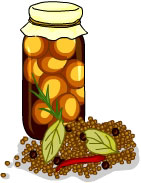How to Make Perfect Pickled Onions
Created | Updated Apr 2, 2009

Pickling is the name given to the technique of preserving food by the use of vinegar. Many vegetables and fruits can be pickled, but this recipe is devoted to the humble onion.
Know Your Onions
There are many onions available throughout the year including Spanish and red varieties, but the two most commonly used for pickling are shallots and pickling or 'baby' onions. The reason for this is simple. They need to be able to fit into a jar.
Although now seen in the marketplace throughout the year, autumn (in the UK) is still the prime time for purchasing the best and cheapest crop. Try to choose onions which are firm with unbroken skins; shallots should not have too much 'growth' shoot showing as this usually means they are past their best.
Five kilograms of onions should make about ten regular jars of pickles. Any vinegar can be used although the best flavours tend to come from malt or spiced rather than white or clear.
Pick Your Pots and Pans
Because the vinegar used is acetic acid, care should be taken when selecting the correct pan to use. Use a good quality stainless steel pan or, even better, an unchipped enamel one, but never use cast iron, aluminium, copper or brass as these will cause an unwanted metallurgic reaction with the vinegar. A pan with a reasonably thick base would also be preferable. Some find a pressure cooker to be the ideal pan, especially when making a large batch.
Any jar can be used but should be thoroughly cleaned, dried and, if being filled warm, placed in the bottom of a very low-heat oven. If you live near a fish and chip shop and ask nicely, they are quite often pleased to give you their finished pickled egg jars. Some more unscrupulous owners may sell them. If not, it is a good way to use all those emptied mayonnaise, chutney or ready-mix sauce jars which form the basis of modern refuse.
If you have inherited granny's Kilner jars even better, but check that the seals are intact and the glass is unbroken.
If the jars you intend to use have screw lids you have no worries - just make sure that the contents of the jar do not reach as far as the lid or protect the metal by using greaseproof or waxed paper. If the lids are missing, don't panic. You can still buy jar covers complete with greaseproof paper and elastic bands. Though not ideal for long storage, they certainly do the trick.
Requirements
Apart from the onions you will need:
- At least half a kilogram of salt
- Two litres of malt vinegar
- 125 grams of pickling spice
- 50 grams of root ginger
- One small piece of cinnamon stick
- One bay leaf
- Assorted spiced and flavoured vinegars (optional)
Basic Method
Allow plenty of time! A crisp, crunchy pickled onion needs all liquid added to be cold. Spread the task over two or three days.
First make some brine. Take one litre of water and boil it with half a kilo of salt until the salt has dissolved. Put this aside until the mixture is completely cold.
Peel the onions or shallots. Use a very sharp, stainless steel knife to prevent discoloration and remove the skins underwater to save your tears. If the onions are very strong try popping a cube of bread into your mouth.
Submerge the peeled onions in the cold brine. Don't worry if some of the salt has separated itself, just spoon it over the top. Weigh down the onions to make sure they are all covered - a round washing-up bowl with a frying pan lid and a few large books will do the trick.
Leave for at least 24 hours to allow the brine water to penetrate the onions and remove some of their moisture.
Meanwhile, prepare the vinegar. Take a muslin cloth or clean cotton handkerchief and place the pickling spices, ginger, cinnamon stick and bay leaf inside. Close the cloth with string and tie around a wooden spoon so that you can stop it from sinking too far.
Put the malt vinegar into the pan, add two small, peeled onions, a tablespoon of salt and the spice parcel. Bring the vinegar to the boil and boil for five minutes. A word of advice here - the boiling vinegar does not only smell quite strong it also removes oxygen from the air, so make sure that you open windows or doors and take care if you suffer from asthma.
After five minutes, turn off the heat, take out the spice bag and put the vinegar somewhere to cool (but not in the fridge!). One advantage of preparing this in the autumn is that it can safely stay outside overnight if covered.
Rinse the onions well and pack into the jars. Pour over the cold vinegar so that all the onions are covered but take care not to overfill the jar if using screw tops. Seal and place in a cool place. If possible leave for at least a week before eating.
Variations
If you prefer your pickled onions to be soft then pour the vinegar while still hot. Remember to warm the jars in the oven first, or they may shatter.
Experiment!
There are many wonderful specialist vinegars available. Try combining the basic brew with these and create your own flavours. Use about 50/50 for a strong flavour or 25/75 for a more subtle one. Some ideas include tarragon, cider, white, red, and, for a sweet and sour effect, raspberry.

